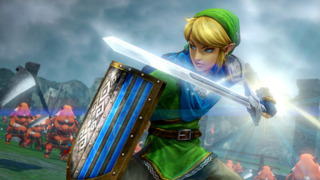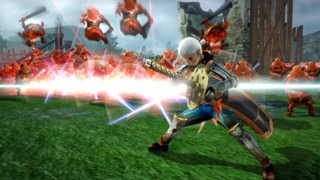
Although Mario and his peers have starred in a great share of spin-offs, Nintendo seems to be far more protective when it comes to its other major franchises, for rare have been the occasions in which the likes of Samus and Link have appeared in games that are far removed from the usual script their adventures adhere to. That is why Hyrule Warriors, the all-out war take on the Zelda universe, arrives as such a big and unexpected effort that aims to deliver a great doses of Hylian magic onto the hands of Nintendo fans before the next actual epic of the series takes place.
The game bears elements that are well-known by anyone who has ever played through a Zelda adventure. Not only are the characters, both primary and secondary, mostly present and ready to do battle, the title does a wonderful job in encompassing other minor details under this unique umbrella. Rupees serve as currency, extravagant Great Fairies can be summoned to help the heroes get out of grueling situations, and assets such as treasure chests, heart pieces, and skulltulas are abundant.
However, in spite of its look and visual cues, Hyrule Warriors' intentions are so clear they are stamped right on its name. The joining of both The Legend of Zelda and Dynasty Warriors inside the same software results in a game whose title merely nods towards the former via the use of the moniker of its usual setting, while blatantly referencing the latter by using the “Warriors” tag. In other words, at heart, this is far from being a Zelda game. It is, in fact, a Dynasty Warriors installment whose building bricks, such as its setting and history, are borrowed from the Zelda universe.
There are no puzzles, no dungeons, and no overworld. Across some of the most famous locations that have served as the proving grounds for the hero garbed in green, large-scale medieval battles occur by letting loose enormous armies consisting of low-rank soldiers and mighty generals against one another. With those pieces set in place, the table becomes set for flashy mass destruction carried out by blades, staffs, harps, spears, and other weapons.

Hyrule Warriors is a game determined to combine as many Zelda references into a package as possible. Therefore, its plot cleverly finds a way to summon characters and places from different games of the saga into the very same point in time. Ganondorf, bent on yet another resurrection, finds a way to corrupt the spirit of a powerful sorceress that protects the balance of time. Possessed by him, she opens up portals to different Hylian eras in order to give servants of the darkness access to the fragments of the demon's body that have been sealed in distinct periods in the timeline.
Needless to say, calamity ensues, and Princess Zelda suddenly finds her kingdom swarmed by hordes of foes. Desperate, she seeks the help of Link and other major characters to erase the threat. Even if the time portals do feel like a forced tool used to bring together the worlds of Skyward Sword, Ocarina of Time, and Twilight Princess, the plot is surprisingly satisfying and, with each passing chapter of the main quest, it receives a nice deal of attention, which constantly keeps events unraveling at an engaging pace.
On its surface, Hyrule Warriors frequently runs a serious risk of coming off as a mindless hack and slash, but that is not entirely true. Sure, most of the enemies faced on the battlefields are nothing but brainless food to a hungry weapon; they fall as easily as a sheet of paper and offer no resistance. Their sole purpose seems to be inflating the number of kills one can get with a single blow.
However, punctually placed here and there, are army leaders and other gargantuan bosses that demand a bit of the patient pattern-solving approach (not to mention the use of certain pieces of equipment) commonly required by the cleverly designed monsters of the Zelda series. Though some of them can still be defeated by hacking away like a mad man, they break a bit of the intense meat-grinding pace of the most mundane battles.

What truly manages to stop the game from being a series of totally empty-headed brawls are its strategic undertones. The moderately sized maps are filled with keeps and outposts from which enemy forces will respawnendlessly. Therefore, in order to truly and slowly gain terrain, it is absolutely necessary that those important locations be taken one-by-one in a planned fashion. Acquiring control over those points is nothing special, all that it takes is mowing down a bunch of enemies, but there is a large strategic value in the ruling over those places and, most importantly, maintaining them safe from eventual reinforcements.
The management of those major positions, not to mention the aid that is frequently requested by friendly captains, is what will keep players busy through most of the missions, smartly diverging their attention from the fact that all they are doing is bringing down groups of enemies over and over again.
Surprisingly, it works fantastically well. Hyrule Warriors is irresistibly fun, and although long playing sessions will eventually reveal the repetitive nature of the game, most players will keep coming for more. The game winds up being a weird kind of guilty pleasure due to the fact it is impossible not to be aware that you are hypnotized by what is mostly brainless battles.
There is a certain untouchable joy in the killing of thousands of bad guys with such ridiculous ease and the game makes it even more fun by providing a great assortment of characters, each with their own combos, weapons, and quirks. It is possible to customize weapons by transporting the abilities between them, and each character has three skill trees (offensive, defensive, and assist) that must be unlocked by the gathering of material that is dropped by enemies.
It is important to note, though, that there is a certain level of shallowness to both the combos and the skill trees. Given the difference between characters, and the clear possibilities that arise with each of their natures, it is slightly disappointing that the combos are, in terms of button-presses, the same for all warriors, and that the set of skill trees is also identical regardless of the character.

That superficiality is, actually, something that plagues the experience as a whole. Hyrule Warriors is unquestionably entertaining. Unfortunately, it is a game that has a very limited set of tricks. The mission structure that is used on the very first scenario is the same one that will support the final battle. There are no great gameplay twists and turns; the game never truly grows. And the only thing that changes during the progress of the entire adventure is that bosses begin to appear more frequently and in greater numbers.
At the same time, it is also a game of very clear successes. The amount of content packed into the software is commendable. Those who fall victim to the title's addictive nature – and that is much more likely than the game's various flaws might indicate – will easily spend over one hundred hours with Hyrule Warriors before revealing all of its secrets. The main story, with its adjustable difficulty levels and collectibles, already packs quite a punch, but Adventure Mode increases the game's value to unbelievable heights.
On a grid-like map taken straight from the original The Legend of Zelda, players must explore each square (which is a mission with special rules and goals) to acquire items that will allow an 8-bit Link to unlock new areas until he vanquishes evil from the land. It is a pleasantly altered version of a very large challenge mode where new tests are only retrieved through actions performed on an interactive and old-school overworld.
The seemingly interminable amount of challenges, as well as the lengthy main campaign, end up bringing forth Hyrule Warriors' greatest mystery. There is a whole lot to do here, but while most titles that fall into repetitive patterns would not motivate players to keep on going until they have seen everything, Hyrule Warriors manages to keep players coming back for more, whether it is for another quirky mission (where one will, once again, blast through enemy armies with ease) or an attempt to clear a harder level of difficulty.

To top it all off, the game also has an effective cooperative mode where while one player sees his character on the Gamepad screen, the other uses the TV, giving each warrior a great degree of freedom as to where to go next, and allowing players to create their own battle strategies on the move.
Hyrule Warriors ends up being a game of contrasts. Although its graphics are nothing special, its music never does justice to the usual Zelda soundtrack greatness, and its gameplay is limited, the game finds a way to be incredibly addictive and justifies that desire for more by giving players a whole lot of content to play through. In the land of Hyrule, Dynasty Warriors finds a famous and highly beloved skin to wear, and – in return – leaves Zelda fans with a little treat to play while Link prepares to face the forces of darkness once more. This time, in his usual style.

